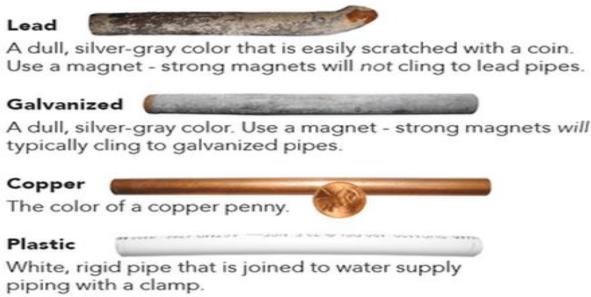About Lead and Copper Rule
EPA REQUIRED WATER SERVICE LINE INVENTORY
The U.S. Environmental Protection Agency has required all water systems, including the Bountiful City WaterDepartment, to provide a comprehensive inventory of the pipe materials that comprise the culinary water service lines. In order to complete our inventory, the Bountiful Water Department needs your assistance to determine the type of pipe at your home or business and report back to us.
How to Identify Service Line Material
Locating and testing your service pipe is expected to take approximately 15 minutes or less.
Step 1: Locate the culinary service pipe where it enters your home. This is typically in a crawl space, basement or utility room.
Step 2: Using the images below, identify the correct location to test the pipe material. The test should be conducted on the pipe which is connected to the water meter, and not on the piping on the interior of the home. The proper test location is typically between the wall or floor where the pipe enters the structure and the shut off valve and/or pressure reducing valve (PRV).
Step 3: Determine the type of pipe material. There are 3 methods than can be used:
- Visual Inspection In some cases, the pipe type can be easily determined as copper or as High Density Polyethylene (HDPE).
- Scratch Test Older pipes can often be covered with a thin layer of oxidized material which needs to be removed to determine the pipe material. Expose the underlying material using a coin or a putty knife. A lead pipe is very soft and can be easily scratched, exposing a bright silver color.
- Magnet Test For pipes that are silver or gray in color, a magnet can be used to determine if the pipe material is an iron/steel based material or lead. A magnet will be attracted and “stick” to an iron/steel pipe but will not do so on a lead pipe.
If you need assistance in locating or testing your service pipe, please contact the Bountiful Water Department by calling 801-298-6180 or by email at leadandcopper@bountiful.gov.
Test Results – What’s Next?
Submit your test results to Bountiful City using the data fields on this page. This information will be incorporated into the City’s inventory database.
As stated earlier, Bountiful City is responsible to replace the utility-owned portion of service laterals that have lead components. This work will be coordinated with property owners and occupants as part of a city-wide replacement program. The service line replacement plan must be submitted to the Utah State Division of Drinking Water in 2027. Work is expected to be completed by 2030.
Bountiful City Water customers who have service lines which are connected to the culinary water system by a lead service (downstream of the City-owned portion of the service connection) are responsible to replace the customer owned portion of their culinary service line. Customers who have a galvanized service line which is not connected to a lead service (on the City-owned portion) are not required to replace their portion of the service line. Customers who have a copper or HDPE culinary service pipe are also not required to take any action.
Why Is This Important?
Exposure to lead in drinking water can cause serious health effects in all age groups. Infants and children can have decreases in IQ and attention span. Lead exposure can lead to new learning and behavior problems or exacerbate existing learning and behavior problems. The children of women who are exposed to lead before or during pregnancy can have increased risk of these adverse health effects. Adults can have increased risks of heart disease, high blood pressure, kidney or nervous system problems.
How Can I Reduce My Exposure to Lead in Drinking Water?
Lead can get in your drinking water as it passes through the plumbing in your house or when it sits in lead pipes for a while. If the material of your pipes is unknown and may be lead, you can reduce your exposure to lead in your drinking water by taking the following steps:
- Let the water run for 3-5 minutes before using it for drinking or cooking if the water has not been turned on in over six hours (other ways to flush your line may include taking a shower, running the dishwasher, or doing laundry). Boiling water does NOT remove lead.
- Clean the screens and aerators in faucets frequently to remove captured lead particles.
- Use cold water for drinking, making food, and making baby formula. Hot water releases more lead from pipes than cold water.
- Test your water periodically. Contact your utility and ask if they have any lead sampling programs for their customers.
- Identify and replace plumbing fixtures and pipes containing lead: Faucets and fittings sold before 2014 are more likely to contain lead. The zinc coating used in the manufacturing of galvanized pipe also contains lead and can be a source of lead contamination.
- Find other ways to get or treat your water, like using bottled water or water filters. You can find certified filters that remove lead by searching online for “certified lead filters
- Use only certified “lead-free” piping and materials for plumbing when building or remodeling.
More Information on Testing and Identifying Culinary Service Pipe Materials:
- How To Check Your Water Service Line Material https://www.lslrcollaborative.org/uploads/9/2/0/2/92028126/howtocheckservicelinelead_18.01.23.pdf
More Information on Lead Contamination:
- Lead In Drinking Water https://www.epa.gov/il/advice-chicago-residents-about-lead-drinking-water
Additional Resources:
- Lead Service Line Replacement Collaborative https://www.lslr-collaborative.org/
- US Environmental Protection Agency Lead and Copper Rule Revisions (LCRR) https://www.epa.gov/ground-water-and-drinking-water/revised-lead-and-copper-rule
- State of Utah Division of Drinking Water Lead and Copper Rule Revisions https://deq.utah.gov/drinking-water/lead-and-copper-rule-revisions





